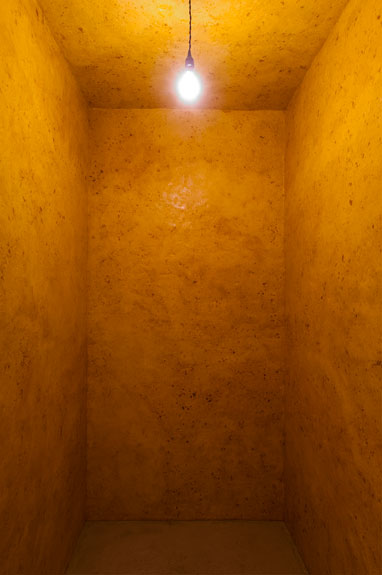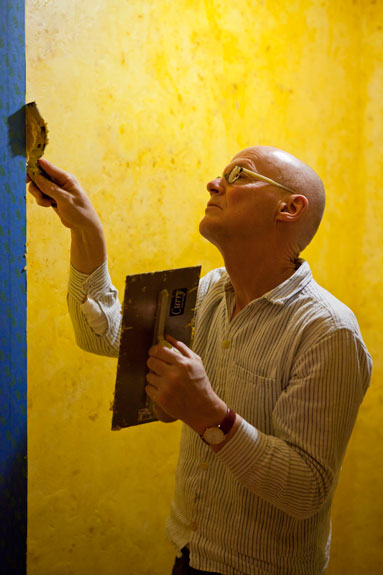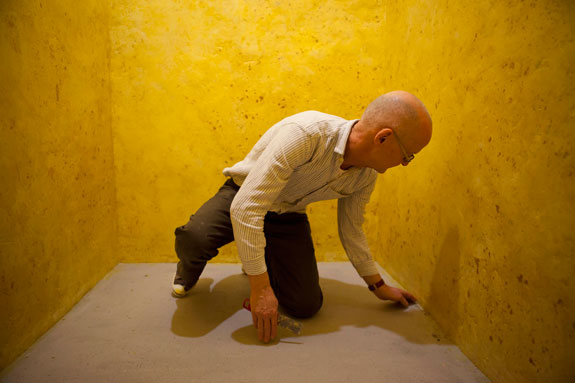The Otherworldly Calm of Wolfgang Laib’s Glowing Beeswax Room
A German contemporary artist creates a meditative space—lined with beeswax—at the Phillips Collection in Washington, D.C.
![]()

Wolfgang Laib, Wax Room. (Wohin bist Du gegangen-wohin gehst Du?/Where have you gone-where are you going?), 2013. The Phillips Collection, Washington, D.C. Photo by Lee Stalsworth.
When I step into the newly installed Laib Wax Room at the Phillips Collection in Washington, D.C., the floral smell of beeswax wafts through my senses. Psychologists say that scents can quickly trigger memories, and this one transports me back to my childhood: The fragrance of the amber beeswax coating the walls instantly reminds me of the crenellated sheets of beeswax, dyed pink and purple, that came in a candle making kit I had as a kid. I remember rolling the sheets into long tapers for Advent.
The warm glow of the closet-sized space is equally comforting. A single light bulb dangles from the ceiling, giving a sheen to the room’s waxy walls. Standing in its center, the spare room has a calming effect—it is a welcomed “time out” in an otherwise overstimulating world. As Klaus Ottmann, curator at large at the Phillips, puts it, the room has the “ability to temporarily suspend reality.”
Wolfgang Laib, a 63-year-old conceptual artist from Germany, created the meditative space. Over the course of a few days in late February, he melted 440 pounds of beeswax, minding the liquefying material carefully because temperature swings could have resulted in batches of varying yellow. Then, he used a warm iron, spackle knives and spatulas to evenly apply the inch-thick coat of wax, like plaster, onto the walls and ceiling of the 6-by-7-by-10-foot space. The Laib Wax Room, as the museum is calling it, opened to the public on March 2.
In his career, spanning more than four decades thus far, Laib has turned many raw, natural materials, such as milk, rice and pollen, into artistic mediums. Earlier this year, in fact, the Museum of Modern Art (MOMA) in New York City exhibited the artist’s Pollen From Hazelnut, an 18-by-21-foot installation made entirely of bright yellow pollen he harvested in the last 20 years.
Beeswax, however, happens to be one of his favorite materials. Since 1988, Laib has created a temporary wax room for MOMA as well as for two museums in Germany and one in the Netherlands. For these, he nailed sheets of beeswax to plywood walls, so that the installation could be disassembled. Then, he developed a more intensive, irreversible process by building a couple of outdoor wax rooms in the past 15 years, in a cave in the French Pyrenees and on his own land in Germany. The Phillips Collection is the very first museum to have a permanent beeswax room.
Visitors to the Phillips Collection are encouraged to enter the Laib Wax Room—titled Where have you gone – Where are you going?—one or two at a time. ”Here this is a very, very small room but it has a very beautiful concentration and intensity,” says Laib, in an audio tour and video produced by the Phillips. “When you come into a wax room, it is like coming into another world.”
/https://tf-cmsv2-smithsonianmag-media.s3.amazonaws.com/accounts/headshot/megan.png)


/https://tf-cmsv2-smithsonianmag-media.s3.amazonaws.com/accounts/headshot/megan.png)